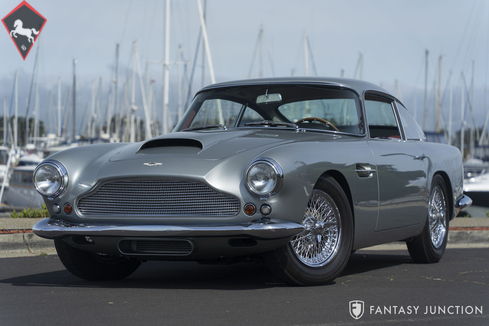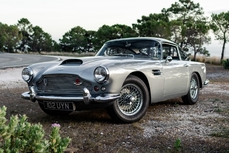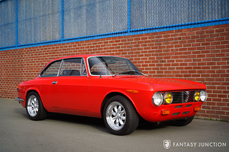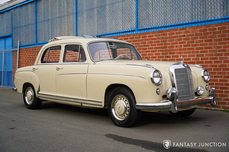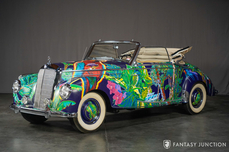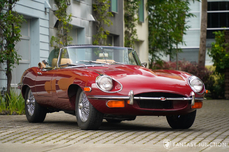Aston Martin DB4 3.7L DOHC Inline 6 Cylinder 1959
General description :
1959 Aston Martin DB4 Series 1
s/n DB4/221/L, Engine no. 370/253
Silver with Red Leather
Aston Martin remains today as one of the finest performance cars built for racing or road use. Throughout their history, Aston Martin has produced truly amazing cars, serving both performance and elegance as the perfect combination of motoring sophistication that remains at the heart of the Aston Martin brand. Succeeding ahead of competitors with far greater resources, Aston Martin has delivered on their promise of performance and elegance, packaging a unique motoring experience that captures the hearts of sporting enthusiasts in search of excellence. When David Brown took the helm, his clever and timely purchase of Lagonda, secured the use of their sophisticated 2.6 liter twin-cam inline six-cylinder engine, designed by none other than W.O. Bentley. The heart of their first ventures into superb road going cars, by the late 1950s Aston Martin would establish a leadership role against many worthy competitors.
With continued success and sales growing, Aston Martin astutely retained the services of the finest Italian coachbuilders for both production cars and one-off show cars. The resultant improvements in the line were immediately evident through the seminal DB series cars, including the DB4, which used the patented Touring Superleggera (Super Light Weight) construction. These hand formed aluminum bodies, mounted over steel sub-structure, were lightweight, beautifully appointed, and offered top-tier performance. They also contributed greatly to establishing the definitive profile for elegant GT automobiles that would follow through the 1960s. The DB4 featured a newly designed 3.7-liter dual overhead cam engine designed by Polish race car driver Tadek Marek. This potent engine was mated to a 4-speed manual gearbox, while four-wheel Girling disc brakes handled stopping duty. Independent front suspension utilized ball-jointed wishbones, coil springs, and rack-and-pinion steering, while the live rear axle employed coil springs and a Watt’s linkage.
Period tests returned impressive results, once again placing Aston Martin at the top of their game in performance while delivering a uniquely conceived design. The Series 1 Touring body was clean, uncluttered with fussy trim, and the ventless side window profile created a pure and elegant statement which remains today one of the most revered and now iconic GT profiles from this prolific era.
This DB4 was purchased by a prominent international vintage sports car enthusiast around the year 2000. According to the current owner, the prior owner, an older Colombian gentleman, and his Swiss wife, discovered this DB4 in Switzerland. The couple intended to import it to their residence in Colombia. At that time, import restrictions were limiting entry into Colombia, so the owner imported the car into Colombia with paperwork and chassis number from a donor DB2, also in his ownership. The prior owner restamped this DB4 using the donor DB2 numbers, then reused his existing DB2 paperwork as a means for the DB4 entry into Colombia. An excellent candidate for restoration, the DB4 body had suffered typical electrolysis but was accompanied by a spare engine and gearbox. According to the current owner, after recognizing the importance of this Series 1 DB4, he engaged a visiting friend and employee of Aston Martin to assist in establishing and then reuniting the car with what is understood by the current owner to be the correct DB4 chassis number for this car. As part of the restoration under the care of Aston Engineering and with Aston Heritage support, the correct chassis number was approved by Aston Heritage, the plate issued, and both a frame stamped number and Aston plate were applied to the car.
During the restoration, the car was treated to expert alloy panel and steel frame handwork as shown in the restoration photos. To complete the car to a high standard, the entire drivetrain, suspension, brakes, electrical, the complete interior, and all glass was removed. The body shell remained in Colombia for specialized body and paint work while the mechanical features were crated and shipped to Aston Engineering in the UK to leverage their expertise in these areas. While the engine and gearbox were being rebuilt in the UK, refinishing for the bare alloy body shell was completed in Colombia using beautiful silver metallic paint accented by the installation of freshly reupholstered red leather interior, using leather and other specialized materials supplied by Aston Martin Heritage. According to the restoration documentation included with the car, in 2006 the owner visited Aston Engineering Ltd where the engine, transmission, rear axle, brakes, front suspension, steering, rear suspension, electrical and interior were all completed. While at Aston Engineering, the engine block and crankshaft were crack tested, machining performed on the engine, and a shallow sump installed. Aston Engineering rebuilt the engine, bored to 4.2-liter specifications, and provided dyno testing indicating 250hp at 5,000 rpm, which is noted in copies of the dyno sheets accompanying the car. At this time, the engine in the car was machined and stamped with a corresponding number that matched the engine number issued by Aston Martin Heritage as stamped on the chassis plate. The finished engine, gearbox, and mechanical features were crated and shipped from Aston Engineering, UK to Colombia for final assembly. As an added feature, electric overdrive was added to the car for improved highway driving. Copies of the restoration receipts reference a complete DB4 wiring loom, 9.5” clutch assembly, steering and wishbone bushings, and numerous hardware and trim parts, to name just a few of the many items restored or replaced on this car. Outside services included instrument restoration, while Aston Heritage materials for the interior include Mulberry leather, black leathercloth, ribbed floor mats, new door handles and escutcheons, red Wilton carpets, Hardura black boot covering, off white headliner, and black vinyl material. The restoration evolved over several years before completion in 2016, when the chassis plate currently on the car was supplied by Aston Martin Heritage and installed on the car. After the restoration was completed, the car arrived in North America for consignment.
Today this beautifully restored Aston Martin elegantly displays all the traits of a handsomely configured Series 1 DB4. The paint quality is of excellent quality with the exception of a paint prep flaw at the front of the passenger’s side cowl near the windshield. The color is very fitting for the alloy Touring coachwork offering one of the best colors to appreciate the elegance of this design. The finish is glossy throughout featuring correct metal flake mixed into the silver finish. The panel gaps are very well done with crisp closure on all strike surfaces and properly detailed inner panel surfaces. The exterior trim is very nice throughout including the beautifully finished Aston Martin grille and chrome plated front and rear bumpers, the latter of which shows light hazing to the topside finish. The body lines are beautifully resolved with excellent body contours and properly controlled reflections particularly in the tailored Touring wheel arches. The clean trunk line brilliantly tapers down while the bladed edges of the rear fender line terminate in elegantly stacked taillight lenses with delicate chrome trim.
The sweeping roofline and rear glass are very sophisticated for the era, while the chrome wire wheels with correct Michelin tires, and triple-ear knockoffs create a flash of competition history on this subtle and sophisticated Grand Touring design. The glass, exterior emblems, lighting, exterior lenses, and turn indicators are all in excellent condition.
Attention to detail, accuracy, and quality materials are equally evident throughout the interior of the car. The supple red leather seats are perfectly tailored with excellent pleat lines and perimeter seat piping as well as proper seat foam in the bolsters. The matching red door panels, red Wilton carpets, and handsomely finished rear seat area are beautifully presented. The painted dashboard finish contrasts elegantly with the delicate chrome accents highlighted by a wonderful array of restored instrumentation filling the driver’s binnacle. A large diameter wood steering wheel with painted spokes is the perfect partner for the floor mounted 4-speed shifter. Nestled beneath the climate control levers, the AM/FM radio and speaker grille finish the center area between the two seats. Overall, the interior delivers an exceptionally fine, authentic appearance including the trunk compartment, which is upholstered with black carpet, concealing a matching wire wheel spare tire nestled into the subfloor tire tub.
The beautifully restored twin-cam engine and engine compartment are presented with excellent finishes, proper fasteners, and period correct components thoughtfully prepared just as delivered when new. The cast alloy engine components are polished to an appropriate luster, not overdone as is often seen. The 4.2-liter engine, bored by Aston Martin Engineering during rebuild, is correctly outfitted with twin Solex carburetors, and a polished fan shroud. A set of correct metal identification plates are properly in place in the engine compartment. The engine bay and all hardware have been expertly refinished to a very high standard, prepared with originality and pride. The undercarriage has also been restored with high quality finishes and is indicative of very few miles driven since completion. The leather rear suspension retaining straps, stainless-steel exhaust system, correctly coated parts, and properly finished suspension components all contribute to a very cohesive restoration.
The driving experience is very satisfying with excellent shifting through the comfortable 4-speed gearbox, which has been thoughtfully updated with electric overdrive. Acceleration from the twin-cam engine, displacing 4.2-liters, is indeed rewarding, with throttle response that comfortably manages leisurely cruising or more spirited intentions, particularly on highway drives with the electric overdrive engaged. The Girling disc brakes operate in balance with the chassis, coming down smoothly and tracking evenly even from higher speeds.
Beautifully finished in iconic colors, this Aston Martin DB4 is ready to offer the next fortunate enthusiast all the joys associated with owning one of the finest examples of GT performance cars ever offered for road use. Powerful and elegant, this wonderful example combines all the traits of enjoyable motoring from a romantic and inspired era that can only be experienced from behind the wheel of a vintage Aston Martin.
Please note that this car is being sold duty paid in the United States on a cancelled Colombian title.
https://fantasyjunction.com/inventory/1959-aston-martin-db4-series-1/overview
1959 Aston Martin DB4 3.7L DOHC Inline 6 Cylinder is listed sold on ClassicDigest in Emeryville by Fantasy Junction for Not priced.
Car Facts
Car type : Car Make : Aston Martin Model : DB4 Model Version : 3.7L DOHC Inline 6 Cylinder Engine size : 3.7 Model Year : 1959 Location : Emeryville Vehicle Registration : Normal
Sold
Seller Information
Sold
People who viewed this Aston Martin DB4 also viewed similar Aston Martin listed at ClassicDigest
Other cars listed for sale by this dealer
About Aston Martin DB4
The Aston Martin DB4 is an iconic model in Aston Martin's history, known for its elegant design, performance, and luxury. Here's an overview of its history, specifications, production numbers, and cultural context:1. History: The Aston Martin DB4 was introduced in 1958 as a replacement for the DB Mark III. It was designed by Carrozzeria Touring of Milan, Italy, and represented a significant step forward for Aston Martin in terms of performance and styling.
2. Specifications:
- Engine: The DB4 initially featured a 3.7-liter inline-six engine, which was later upgraded to a 4.0-liter engine in later models. The power output ranges from approximately 240 to 266 horsepower, depending on the specific variant.
- Transmission: It was equipped with a 4-speed manual transmission, and some later models were offered with a 3-speed automatic transmission as an option.
- Performance: The DB4 was capable of achieving a top speed of around 140 to 150 mph (225 to 240 km/h) and could accelerate from 0 to 60 mph (0 to 97 km/h) in approximately 8 seconds.
3. Production Numbers: The production numbers for the Aston Martin DB4 are as follows:
- Aston Martin DB4 (1958-1963): Approximately 1,113 units produced across various body styles and variants.
4. Cultural Context: The Aston Martin DB4 represented a significant leap forward for Aston Martin in terms of design and performance. It showcased a blend of British craftsmanship and Italian styling, incorporating lightweight construction techniques and elegant lines. The DB4's luxurious and sporty character made it a desirable choice for discerning buyers, including celebrities and enthusiasts.
The DB4's success on the road and its participation in motorsport events further enhanced its reputation. It competed in various racing and rallying events, achieving notable successes, including class wins and overall victories in races such as the Le Mans 24 Hours and the RAC Tourist Trophy.
The Aston Martin DB4 remains an iconic and highly sought-after classic car today. Its timeless design, powerful performance, and connection to Aston Martin's heritage have made it a symbol of automotive excellence and desirability. Collectors and enthusiasts value the DB4 for its rarity, craftsmanship, and historical significance within the Aston Martin lineup.
"Superleggera" is an Italian term meaning "super light" or "super lightweight." It is often associated with the coachbuilding company Carrozzeria Touring Superleggera, which has been known for its lightweight construction techniques used in the creation of various iconic automobiles.
Carrozzeria Touring Superleggera is credited with popularizing the superleggera construction method, which involved using a lightweight framework of small-diameter steel tubes covered with hand-formed aluminum panels. This construction technique reduced the overall weight of the vehicle while maintaining structural integrity.
The term "Superleggera" has also been used by several automakers, including Aston Martin, Lamborghini, and others, to denote special lightweight or high-performance versions of their vehicles. These vehicles often feature weight reduction measures, aerodynamic enhancements, and increased power output to deliver enhanced performance and driving dynamics.
For example, Aston Martin has used the "Superleggera" designation on models such as the Aston Martin DBS Superleggera, which represents the ultimate expression of performance and luxury in the Aston Martin lineup. These vehicles typically feature powerful engines, advanced aerodynamics, and extensive use of lightweight materials to achieve a perfect balance between performance and luxury.
In summary, "Superleggera" refers to the concept of lightweight construction and has been associated with both the Carrozzeria Touring Superleggera coachbuilder and specific high-performance models from various automakers. It represents a pursuit of weight reduction and improved performance without compromising on style and luxury.
